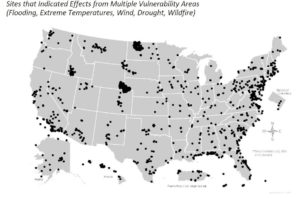In January 2018, the U.S. Department of Defense (DoD) published the results of a DoD-wide survey to assess the effects of extreme weather events on U.S. military bases. Here are some highlights of the DoD report, how this affects military environmental planning, and what’s next.
DoD Climate Change Report Summary: The report is an initial vulnerability assessment of all 3,500 DoD installations and sites worldwide intended to identify any negative effects experienced from extreme weather effects on DoD assets and the surrounding communities directly involved with providing supporting services.
What are the most vulnerable DoD asset categories? The top five assets with one or more effects due to severe weather events were:
- airfield operations,
- transportation infrastructure,
- energy infrastructure,
- training/range facilities, and
- water/wastewater systems.
How does this affect military installations and their climate change NEPA analysis?
Shortly after President Trump took office, the Council of Environmental Quality (CEQ) withdrew its final guidance for federal agencies on consideration of the effects of climate change in National Environmental Policy Act (NEPA) reviews “for further consideration.”
Although CEQ repealed the climate change guidance and how climate change should be addressed in NEPA documents, some installations are still relying on the final CEQ guidance.
Most installations are already somewhat aware of their vulnerability to extreme weather based on history. Installations might apply the results of the DoD climate change report to evaluate vulnerability to extreme weather and regional trends. These can then be factored in their NEPA analysis and planning studies. One big challenge will be the science of predicting climate effects in specific locations and the certainty of that modeling data.
Additional topics for future assessment could include:
- lost mission days,
- asset criticality level,
- damage cost estimates, and
- human health aspects.
The definition of DoD installations and sites was broad. The map below illustrates the effects at U.S. military sites as a result of extreme weather to include flooding, extreme temperatures, wind, drought, and wildfire.
The highest number of reported effects resulted from drought, wind, and non-storm surge related flooding. While I expected to see high numbers in coastal areas, it was surprising to see the extent of effects in inland areas – a stark reminder that climate change impacts can be nationwide.
What the report didn’t address? The report recognizes that “the information collected from these surveys is highly qualitative” and “is best used as an initial indicator of where a more in-depth assessment may be warranted.” While individual bases may be separately collecting quantitative data, it’s unclear whether DoD has plans to conduct future comprehensive DoD-wide assessments.
One thing is certain: DoD recognizes the urgency in addressing climate change. As stated by Ray Mabus, Secretary of the U.S. Navy from 2009 to 2017, “Climate change is real, we’ve got to address it, [rather] than argue about what we’re basing it on.” (see full video here)
This is a dynamic and challenging time for defense communities and their facilities. The more we know, the more we can actively plan for future changes. Scout Environmental looks forward to crafting viable dialogue with the spectrum of professionals engaged in this issue to help identify proactive solutions to climate change-related challenges.
For further inquiries, please contact me at: melanie.hernandez@scoutenv.com














